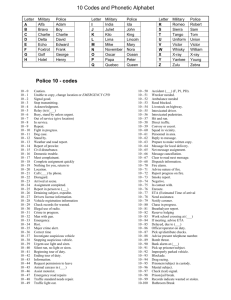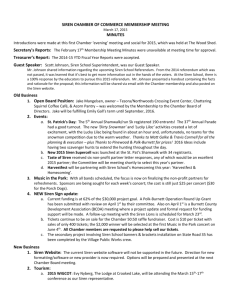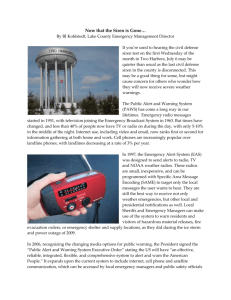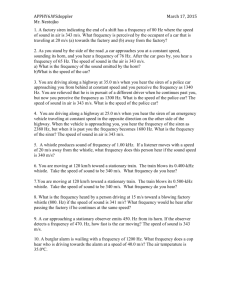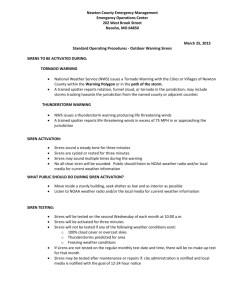Localisable Alarms
advertisement
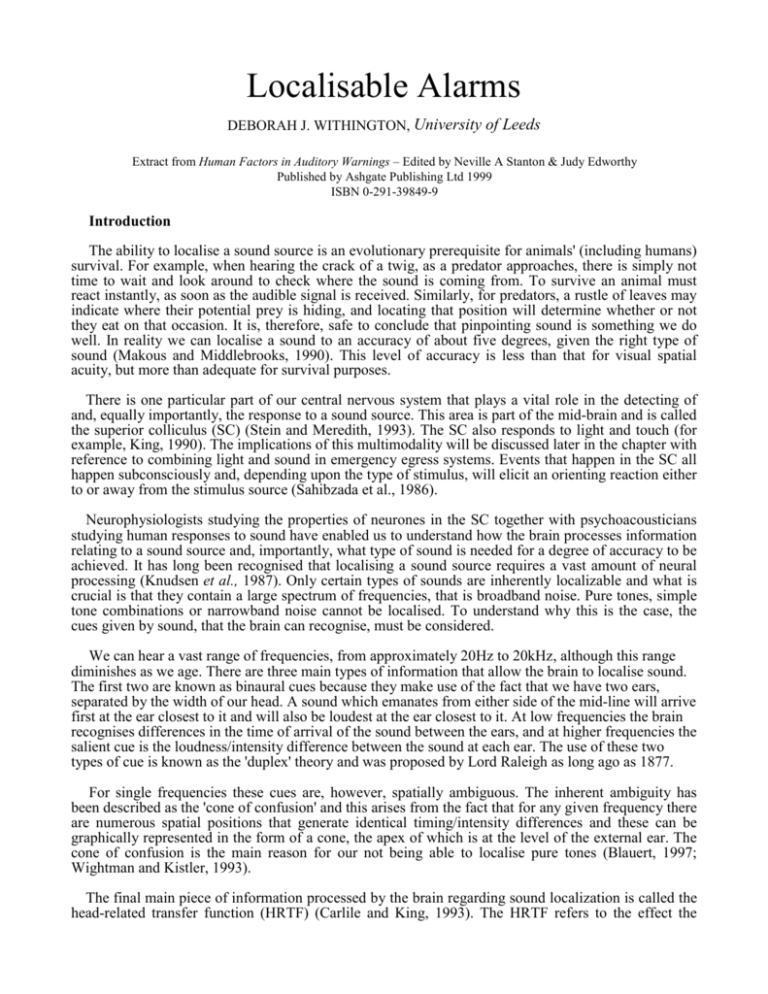
Localisable Alarms DEBORAH J. WITHINGTON, University of Leeds Extract from Human Factors in Auditory Warnings – Edited by Neville A Stanton & Judy Edworthy Published by Ashgate Publishing Ltd 1999 ISBN 0-291-39849-9 Introduction The ability to localise a sound source is an evolutionary prerequisite for animals' (including humans) survival. For example, when hearing the crack of a twig, as a predator approaches, there is simply not time to wait and look around to check where the sound is coming from. To survive an animal must react instantly, as soon as the audible signal is received. Similarly, for predators, a rustle of leaves may indicate where their potential prey is hiding, and locating that position will determine whether or not they eat on that occasion. It is, therefore, safe to conclude that pinpointing sound is something we do well. In reality we can localise a sound to an accuracy of about five degrees, given the right type of sound (Makous and Middlebrooks, 1990). This level of accuracy is less than that for visual spatial acuity, but more than adequate for survival purposes. There is one particular part of our central nervous system that plays a vital role in the detecting of and, equally importantly, the response to a sound source. This area is part of the mid-brain and is called the superior colliculus (SC) (Stein and Meredith, 1993). The SC also responds to light and touch (for example, King, 1990). The implications of this multimodality will be discussed later in the chapter with reference to combining light and sound in emergency egress systems. Events that happen in the SC all happen subconsciously and, depending upon the type of stimulus, will elicit an orienting reaction either to or away from the stimulus source (Sahibzada et al., 1986). Neurophysiologists studying the properties of neurones in the SC together with psychoacousticians studying human responses to sound have enabled us to understand how the brain processes information relating to a sound source and, importantly, what type of sound is needed for a degree of accuracy to be achieved. It has long been recognised that localising a sound source requires a vast amount of neural processing (Knudsen et al., 1987). Only certain types of sounds are inherently localizable and what is crucial is that they contain a large spectrum of frequencies, that is broadband noise. Pure tones, simple tone combinations or narrowband noise cannot be localised. To understand why this is the case, the cues given by sound, that the brain can recognise, must be considered. We can hear a vast range of frequencies, from approximately 20Hz to 20kHz, although this range diminishes as we age. There are three main types of information that allow the brain to localise sound. The first two are known as binaural cues because they make use of the fact that we have two ears, separated by the width of our head. A sound which emanates from either side of the mid-line will arrive first at the ear closest to it and will also be loudest at the ear closest to it. At low frequencies the brain recognises differences in the time of arrival of the sound between the ears, and at higher frequencies the salient cue is the loudness/intensity difference between the sound at each ear. The use of these two types of cue is known as the 'duplex' theory and was proposed by Lord Raleigh as long ago as 1877. For single frequencies these cues are, however, spatially ambiguous. The inherent ambiguity has been described as the 'cone of confusion' and this arises from the fact that for any given frequency there are numerous spatial positions that generate identical timing/intensity differences and these can be graphically represented in the form of a cone, the apex of which is at the level of the external ear. The cone of confusion is the main reason for our not being able to localise pure tones (Blauert, 1997; Wightman and Kistler, 1993). The final main piece of information processed by the brain regarding sound localization is called the head-related transfer function (HRTF) (Carlile and King, 1993). The HRTF refers to the effect the external ear has on sound. As a result of passing over the bumps or convolutions of the pinna, the sound is modified so that some frequencies are attenuated and others are amplified. Although there are certain generalities in the way the sound is modified by the pinnae, the HRTF of any one person is unique to that individual. The role of the HRTF is particularly important when we are trying to determine whether a sound is immediately in front of, or directly behind, us. In this instance the timing and intensity differences are negligible and there is consequently very little information available to the central nervous system on which to base a decision of 'in front' or 'behind'. So, to locate the direction of a sound source, the larger the frequency content, to overcome the ambiguities inherent to single tone sounds, the better the accuracy. Knowing that we need a multi-frequency sound for localization, how can this be combined with our need to use sound as an alarm? There are a myriad of different uses for sound in alarms and in some cases the addition of a localisability component would be superfluous. However, there are other alarms in which the lack of localisability/directionality is potentially highly dangerous. An excellent example of the latter is the siren used by emergency vehicles (Withington and Chapman, 1996). An everyday occurrence for the majority of drivers is the sound of an emergency vehicle siren, whether from an ambulance, police car or fire appliance. When the emergency siren is heard, drivers look all around, trying to determine from which direction the sounds are coming. The visual cue is required because the sound alone gives no clue as to which direction the vehicle is coming from. The driver is not able to take appropriate avoiding action until the emergency vehicle is seen, often too late to allow a clear path to be created for the emergency vehicle. The uncertainty regarding the direction of approach costs lives. Any improvement in the sound quality of the siren, which enables road users to take earlier evading action, would both reduce the journey time and enhance the safety for emergency vehicles attending emergencies and thus strengthen the service provided. It would also be safer for road users, pedestrians and drivers alike. Difficulties in determining the direction from which emergency vehicle sirens are approaching are widely acknowledged. In fact the emergency vehicle siren has been described as 'an extremely limited audible warning device' (De Lorenzo and Eilers, 1991). A recent study in the Annals of Emergency Medicine has shown that an ambulance is most susceptible to collisions with other vehicles when crossing road junctions. This happens, primarily, because the drivers of the cars or trucks are unable to determine accurately the direction of the approaching ambulance. In one year, in the USA alone, 537 injuries and 62 deaths arose from accidents involving ambulances (Hunt et al., 1995). So why do they not work? Simply, because the frequency content of the siren sounds is so poor. Typically emergency vehicle siren sounds are emitted over the frequency range 500Hz-1.8kHz, far too narrow a frequency range for localization. Although the anecdotal evidence is plentiful, there has not been, until recently, a thorough study into the localisability of emergency vehicle sirens. The lack of research has been due, primarily, to the difficult nature of tackling such a concept in a meaningful way. It would be of little value, for example, to test siren sounds by asking people seated in a room, or in the open, where they thought the sound originated. The 'realism element' was overcome in a recent study at Leeds University in which participants 'drove' in a simulator (Withington, 1996). Experimental Study Approximately 200 participants (age range 19 to 57 years) were tested. They all had previous driving experience. A hearing test, in the form of an audiogram, which tested the ability to hear a range of frequencies, was performed on most participants. Eight loudspeakers were positioned at 45 degree intervals around the car's azimuthal plane. The speakers were not visible to the participants, and the sound from each speaker was intensity and spectrality matched at a position which marked the driver's head within the car. Matching each speaker in the way described resulted in the only variable each time the sound was played being that of direction. A response panel was mounted by the steering wheel in the car. There were 16 positions marked on the panel which represented the horizontal plane around the car. This allowed greater accuracy in determining the errors made by the participants than just having eight response buttons that corresponded directly to the number of speakers. On hearing a siren sound noise, participant drivers pressed the response button that they judged as equating to the location from which the sound originated. The sound source location was varied randomly, with the constraint that in each session all eight speaker positions were activated twice. The participants began trials after a period of familiarization with the car (a 10-minute 'drive' along a preset rural route). During the trials the participants were asked to maintain a speed of 40 mph which the experimenter monitored continuously. Four existing sirens were tested. These were the 'hilo' siren characterized by a two-tone sound (6701100Hz, 55 cycles/min); the 'Pulsar', a pulsating sound (500-1800Hz, 70 cycles/min.); the 'wail', a continuous sound rising and falling (500-1800Hz, 11 cycles/min) and the 'yelp', a continuous and fast warbling sound (500-1800Hz, 55 cycles/min). In each trial the same siren sound was used. The siren used was delivered at or around road junctions on the test track. Data were gathered showing conclusively the poor localization characteristics of existing sirens, though some were better than others; for example, the traditional 'hilo' siren was significantly worse for localisation than the 'yelp'. Nevertheless even the best of the current sirens was associated with exceedingly poor front/back accuracy: participants had difficulty identifying whether the sound emanated from the front or rear of the car, to the extent that they were wrong more often than not. It is worth noting that, if participants just guessed front or back, in theory they would have been correct 50 per cent of the time. In the aforementioned study, in addition to testing the existing siren sounds, a range of new sounds optimised for both alerting (Patterson, 1982, Haas and Edworthy,1996) and localisation were also tested. The data obtained from the simulator studies using the new siren sounds, characterized by pulses of rapidly rising frequency sweeps followed by a burst of broadband noise, indicated a much better localisation than with the old sirens. With the front/back decision, participants got it right 82 per cent of the time (whereas, with the old siren, front/back was incorrectly judged 56 per cent of the time), and left/right accuracy was increased to 97 per cent (from 79 per cent). Following the simulator trials it was necessary to test the new siren sounds in real emergency situations. The new sounds were used in trials with ambulances in West Yorkshire and London, fire appliances in Leicestershire and a police pursuit car in West Yorkshire. Road Trials The road trials produced data which complemented the simulator trials (Withington and Paterson, 1998). Using an on-board video camera, which recorded the view of the road ahead of the emergency vehicle, road user responses to both the old siren and the new sirens were compared. As a result of discussions with the drivers of the emergency vehicles, various road user behaviours were searched for, such as other road users failing to indicate their proposed direction of manoeuvre. The data showed that with the new siren ambulance lane changes were reduced threefold, so making journeys smoother and faster. Instant recognition of the direction of the ambulance's approach increased by nearly 25 per cent, which meant that other drivers cooperated more quickly and more effectively with the ambulance's passage. Clearer, wellsignalled manoeuvres by road users were more achievable and increased by 17 per cent. Finally journey times were reduced by up to 10 per cent. This reduction in journey time was not due to the fact that the emergency vehicle was travelling faster and, often, owing to the natural caution of driving with something new, their speed was actually less. It was due, rather, to the fact that the journey was made easier by road users reacting more quickly, and more appropriately, to the new siren, allowing a clearer path through the traffic for the emergency vehicle. It seems, therefore, that the two crucial requirements of a siren sound, to alert road users to the presence of an emergency vehicle and to inform the listeners of the direction of approach, can be met by utilising our scientific knowledge of the best types of sounds to fulfil these criteria, thus resulting in a more effective sound signal. Other Applications There are many other cases in which changes in the nature of the sound would enhance the efficacy of the application. For example, distress signal units (DSUs), personal alarms worn by firefighters, are activated under conditions of extreme urgency. The sound emitted should not only alert colleagues of the stricken firefighter, but should also provide useful information to aid their search for him or her. Existing DSUs use single-tone, relatively high-frequency signals of approximately 3kHz. These sounds are not ideal in terms of perceived urgency and, more importantly, they are impossible to localize. Localisation errors are, in fact, greatest for sounds around 3kHz (Stevens & Newman, 1936). Research is currently under way at the University of Leeds to improve the sounds emitted by DSUs. It is also worthwhile considering applications in which the addition of a sound would enhance the function. An example of this is the addition of sound to emergency egress lighting systems. Effective emergency egress is of paramount importance for individuals whether it be from aeroplanes, hotels, industrial complexes or ferries and even in the home environment. It is surprising, therefore, that the locations of emergency exits and/or escape routes are indicated solely by visual means. Any auditory information is provided in the guise of an 'alarm' which merely alerts people to the imminent danger. It could be argued that we are, primarily, visual creatures, and there is no doubt that we have a phenomenal accuracy when pinpointing a spatial visual signal (to a fraction of a degree); hence visual instruction for emergency egress should suffice. There are two arguments that can be used against the contention that visual signs alone are optimal for egress. Firstly, research has shown that the area of the brain that responds to spatial sensory information (the superior colliculus), which also initiates the response to the sensory stimulus, contains cells that respond to more than one sensory modality. These neurones respond to light by itself and also to sound alone. However, when light and sound are presented together the response of these cells is far greater than the summation of the response to either modality alone (Stein and Meredith, 1993). In other words, to activate an individual to 'flight', a stimulus containing both light and sound will be far more effective than light or sound alone. Secondly, and most importantly, there are many situations in which our visual ability can be hampered, for example in the case of smoke or chemical fumes, or as a result of an inherent visual disability (Rutherford, 1997). In these instances it is imperative that an alternative modality be activated, and the use of sound is the obvious solution. It is important to note that the combination of some types of sound with emergency lighting would do more harm than good. Sounds with poor frequency content, and even instructions conveyed by speech (which is in effect narrowband noise), are inappropriate for emergency egress as they do not convey 'directional' information. Tests at Leeds University in a smoke-filled environment, filmed by a thermal imaging camera, showed that it took a subject 3 minutes 50 seconds to find a conventional exit sign, relying predominantly on their memory of the immediate environment. In contrast, when an appropriate sound was added to the standard sign the same individual took 15 seconds to find their way out of the hazardous environment. Conclusions Sound is incredibly versatile as a means of locating emergency egress routes. Varying the pattern of noise can draw people along complex routes. Furthermore addition of melodic complexes can provide 'up' or 'down' information which could be placed at strategic stairwells on an exit route. Finally it is worthwhile noting that in control rooms which may house vast consoles, including many visual and auditory signals to alert or warn the operators of a myriad of problems, the use of pure tone alarms may, by their very nature of inherent spatial ambiguity, cause unnecessary confusion for the operator. Furthermore, in the quest to reduce the number of signals in such busy environments, it may be possible to include directional characteristics in such warning alarms so that optimal visual and auditory alarms are created. References Blauert, J. (1997) Spatial Hearing, Cambridge, MA: MIT Press. Carlile, S. and King, A.J. (1993) 'Auditory Neuroscience: from outer ear to virtual space', Current Biology, 3, 446-8. De Lorenzo, R.A. and Eilers, M.A. (1991), 'Lights and Siren: A review of emergency vehicle warning systems', Annals of Emergency Medicine, Z0, 1331-5. Haas, E.C. and Edworthy, J. (1996) 'Desigrung urgency into auditory warnings using pitch, speed and loudness', Computing and Control Engineering Journal, August, 193-8. Hunt, C.R., Brown, L.H., Cabinum, E.S., Whitely, T.W., Prasad, N.H., Owens, C.F. and Mayo, C.E. (1995) 'Is ambulance transport time with lights and siren faster than without?', Annals of Emergency Medicine, 20, 507-11. King, A.J. (1990) 'The integration of visual and auditory spatial information in the brain', in D.M. Gutherie (ed.), Higher Order Sensory Processing, Manchester: Manchester University Press. Knudsen, E.l., du Lac, S. and Esterley, S.D. (1987) 'Computational maps in the brain’, Annual Review of Neuroscience, 10, 41-65. Makous, J.C. and Middlebrooks, J.C. (1990) 'Two-dimensional sound localization by human listeners', Journal of the Acoustical Society of America, 87, 2188-200. Patterson, R.D. (1982) 'Guidelines for Auditory Warning Systems on Civil Aircraft', CAA paper 82017, London: Civil Aviation Authority. Rutherford, P. (1997) 'Auditory navigation and the escape from smoke filled buildings' in R. Junge (ed.), CAAD Futures, Proceedings of the 7th International Conference on Computer Aided Architectural Design Features, Dordrecht: Kluwer Academic Publishers. Sahibzada, N., Dean, P. and Redgrave, P. (1986) 'Movements resembling orientation or avoidance elicited by electrical stimulation of the superior colliculus in rats, Journal of Neuroscience, 6, 723-33. Stein, B.E. and Meredith, M.A. (1993) The Merging of the Senses, Cambridge, MA: MIT Press. Stevens, S.S. and Newman, E.B. (1936) 'The localization of actual sources of sound', American Journal of Psychology, 48, 297-306. Wightman, F.L. and Kistler, D.J. (1993) 'Sound Localization', in W.A. Yost, A.N. Popper and R.R. Fay (eds), Human Psychophysics, New York: Springer-Verlag. Withington, D.J. (1996) 'The quest for better ambulance sirens', Ambulance UK, 11, 20-21. Withington, D.J. and Chapman, A.C. (1996) 'Where's that siren?', Science and Public Affairs, Summer, 5961. Withington, D.J. and Paterson, S.E. (1998) 'Safer Sirens', Fire Engineers Journal, 48, 6-10.

